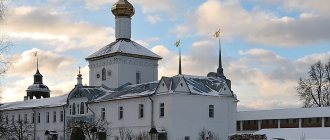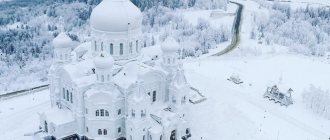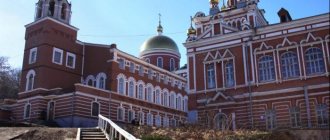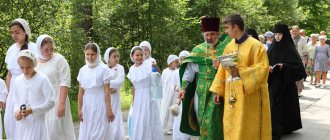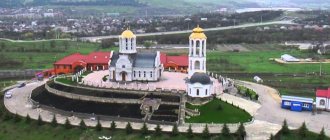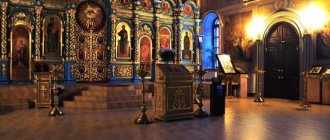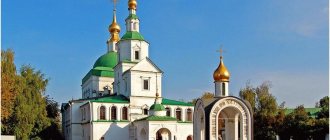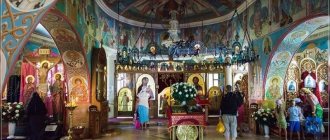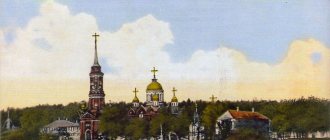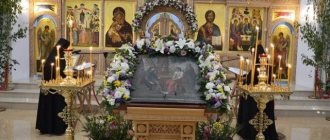The Tolgsky Monastery is one of the largest convents in Russia, and it was also the first monastery opened in Soviet times. Its history goes back more than 700 years, and the most amazing thing is that not only the buildings of the 17th–18th centuries have been preserved here, but also the main shrine of the monastery - the icon of the Tolga Mother of God, the patroness of the Yaroslavl land, famous for its numerous miracles.
The name of the monastery “Tolgsky” comes from the name of the Tolga river, which previously flowed into the Volga 10 km above Yaroslavl. The word “Tolga” itself translated from the Finno-Ugric language means “bird feather”.
Next to the Tolgsky Monastery there is a unique park made of Siberian cedar, which can only be visited with a guided tour. The air in the monastery is saturated with divinity and peace. It is undoubtedly worth coming to the Tolgsky Monastery; it is an incredibly beautiful place where we are filled with a special state of mind.
Legend of the founding
The history of the Tolga Monastery began in 1314 and is associated with a very interesting legend. These were difficult times, when the Russian people suffered from the Tatar-Mongol yoke, they suffered not only physically, but also spiritually. From the constant sight of blood and violence, people became more indifferent and ruder; only faith, the spiritual heritage of his ancestors, helped the Russian man to survive and withstand. In despair, people prayed to the Most Holy Theotokos to deliver them from captivity by the wicked people. Under such circumstances, on August 8, a miracle appeared to Saint Prokhor (in schema Tryphon), returning from a pastoral trip to Beloozero, in a dense forest near Yaroslavl. The bishop woke up at midnight from a bright light, the source of which, meanwhile, was not visible. Looking at the opposite bank of the Volga, he saw a pillar of radiant light rising from a pine forest, from which an amazing bridge stretched across the river. Having prayed to God and taken his staff, the saint crossed this bridge to the opposite bank and in the air near the crown of one of the trees he saw the image of the Mother of God. After a long prayer, he secretly returned to his tent, deciding to hide his night vision from everyone. However, in the morning, getting ready to set off, the bishop’s servants could not find his staff, which they reported to Prokhor himself. Then he realized that the Lord was giving him a sign to reveal the miracle he had seen.
Pointing to the Volga, the saint spoke about what he had witnessed, then ordered the servants to swim across the river and find the staff. The servants found the bishop's staff, and next to it among the trees stood an icon of the Most Holy Theotokos. The servants were afraid to touch the shrine, not having a blessing, and, taking only the staff, they returned to the bishop, to whom they told about everything. Then Saint Prokhor took all his servants, swam across the Volga and, seeing the icon that appeared to him at night, literally in one day he built and consecrated a wooden temple, the frame for the newly found shrine. This is how the Tolga Monastery was founded, which received its name from the Tolga River, which flows into the Volga in this place.
History of the Tolga Monastery
Unfortunately, little is known about the first two centuries of the monastery’s existence. The source of the few facts of that time are the records of chroniclers in the legends about the icon of the Tolga Mother of God. The first event recorded in the Legends is the miracle of the flow of myrrh of the Mother of God and the Child in September 1392, which occurred during a morning prayer service. Myrrh turned out to be healing; many sick people, anointing themselves with it, received healing. Since then, the icon of the Tolga Mother of God has been revered as a myrrh-streaming icon. The second miracle is the miraculous rescue of the icon from a fire at the beginning of the 15th century. The fire that engulfed the Tolga Monastery instantly destroyed the wooden buildings; the monks did not even have time to save any of the church utensils. Most of all they grieved for the lost miraculous icon. But after eliminating the fire in the forest, the monks again found the icon on the tree, completely undamaged by the fire. A chapel was founded on this site, where a copy of the Tolga image of the Mother of God was placed.
By the middle of the 15th century, tired of the constant oppression of the Zasekin princes, the monks turned to Grand Duke Vasily the Dark for protection. The petition was satisfied by the prince, which ensured the monastery the attention of Russian autocrats for many centuries. In 1553, the Tolgsky Monastery (Yaroslavl) was first visited by Ivan the Terrible, who was brought here on a stretcher, but after fervent prayer at the icon, the king was healed. In gratitude for the miracle that had happened, Ivan the Terrible ordered gold and jewelry to be allocated to decorate the image, as well as to build a stone temple and establish the now famous cedar grove. The Vvedensky Cathedral became the first stone building in the Tolga Monastery.
During the years of the Great Troubles, the monastery suffered a difficult ordeal. In 1609, it was plundered by Lithuanian invaders, and after the interventionists set fire to the cells, martyring 46 inhabitants who took refuge in the temple. In the first half of 1612, Minin and Pozharsky chose the Tolgsky Monastery to house the people's militia. Yaroslavl in those days actually served as the capital of the Russian state, the city was densely populated, sanitary conditions were terrible, and an epidemic began. In this situation, around Yaroslavl, on the initiative of the abbot of the monastery, a religious procession with the Tolga icon was held, after which the epidemic receded.
From 1673 until the beginning of the 18th century, active stone construction began in the monastery, laying the foundation of the modern monastery. The abbot managed to find rich benefactors, with whose donations the following were built: the Holy Gates with the Church of St. Nicholas the Wonderworker, the towers and walls of the monastery, the abbot's building, and the Vvedensky Cathedral. In the 17th-19th centuries, the monastery was visited several times by the royal family. In 1763, Catherine the Great made a walking pilgrimage here, in 1863, Tsarevich Nikolai Alexandrovich visited the monastery, and in 1913, during the celebration of the tercentenary of the Romanov dynasty, the last Emperor of All Rus', Nicholas II, visited the Tolga Monastery with his wife and daughters.
In the post-revolutionary years, the monastery suffered greatly. After the uprising in Yaroslavl, all the property of the monastery was described and nationalized. In the 10-15 years of the 20th century, the abbot of the monastery was Hieromonk Seraphim, who later suffered martyrdom from the Bolsheviks. In December 1918, monks from Kazan moved to the Tolgsky monastery, which after the Yaroslavl uprising was turned into a concentration camp. At the end of 1928, the last service was held in the Vvedensky Cathedral, and in March of the following year the monastery was officially closed and the bells and crosses were thrown off.
In 1947, the Soviet authorities recognized the architectural ensemble of the monastery as a historical and cultural monument, but these were only words. Since 1960, a colony for minors was located next to it; its staff lived in a house specially built for them on the territory of the monastery, near the birch park. In subsequent years, other colony buildings were built near this house, which grew into the village of Tolga. The monastery cemetery was looted and destroyed, the burial vault under the Vvedensky Cathedral was destroyed, and a kennel and stable were built in the cathedral itself. This state of affairs continued until the 80s. At the end of the autumn of 1987, the children's colony left the territory of the monastery, the monastery was returned to the Orthodox Church and resumed its activities as a women's colony. The Tolgsky convent became the first monastery to be reopened in the USSR. The first residents found here a real horror of desolation and destruction, of which nothing now reminds us.
Tolga Icon of the Mother of God
As the legend says, the iconographic face of the Mother of God appeared on August 21 (8th old style) 1314 to Saint Prokhor, Bishop of Rostov and Yaroslavl, who, together with his companions, was returning from Belozerye to his cathedral city. The journey along Sheksna and the Volga was long and difficult. The travelers stopped for the night on the coast at the mouth of the Tolga River. At night, the archpastor was awakened by a bright light. Coming out of the tent, he saw a pillar of fire on the opposite bank. The reflection of the flame in the Volga water formed a light path like a lunar one. The bishop crossed himself and, leaning on the holy staff, walked across the water, illuminated by an unearthly radiance, as if on dry land. The image of the Most Pure Virgin holding the baby Jesus Christ in her arms floated in the air. The bishop fell to his knees and began to pray until he fainted.
Waking up in the morning in his tent, he decided that what happened at night was a dream, but, not finding his staff anywhere, he decided to move by boat to the place of the mysterious sign. It turned out that he had not dreamed of the night vigil. An icon lay on the ground next to the bishop's staff. The Bishop and servants took axes in their hands and began to cut down the forest in order to erect a wooden temple at the site of the appearance of the Mother of God. The news of the miracle quickly spread throughout the area. Yaroslavl residents flocked to Tolga in droves and joined the builders. By noon the church was ready, and in the evening it was consecrated in the name of the Entry of the Most Holy Theotokos into the temple.
Over the course of half a century, a monastery was formed, where pious monks and pilgrims flocked. In terms of the time of its foundation, the monastery is older than Valaam, the Solovetsky Monastery and the Trinity-Sergius Lavra.
In 1392, the icon began to stream myrrh. However, soon the wooden buildings were destroyed by fire, and the cathedral church also burned down. The icon was initially considered lost, but a new miracle happened - it was found safe and sound in the branches of a cedar.
In 1553, Ivan the Terrible visited the Tolga Monastery. As the chronicles testify, the king was cured of a leg disease after he prayed at the shrine. The grateful monarch donated funds for the construction of stone cathedrals.
During the Time of Troubles in the 17th century, the monastery was invaded by Polish-Lithuanian invaders, 46 unarmed monks were killed. The miraculous icon was saved.
In 1612, during the gathering of the militia of Minin and Pozharsky in Yaroslavl, a pestilence broke out. The epidemic, which spread quickly due to the large crowd of people, stopped immediately after the religious procession with the Tolga icon of the Mother of God. In 1636, the image of the Mother of God with her son saved the Yaroslavl region from famine caused by crop failure, in 1654 - from a pestilence, in 1657 - from a terrible drought.
The Tolgsky monastery was visited more than once by the most august persons: Peter I, Empress Catherine the Great, Emperor Nicholas II and his family.
The Soviet government turned the monastery lands and buildings into a colony for juvenile delinquents and warehouses. On the eve of the 1000th anniversary of the Baptism of Rus', in 1987, the destroyed Tolga Monastery complex was transferred to the Russian Orthodox Church. By decision of the Holy Synod, the first women's monastery in the USSR was established on the territory of the monastery (after the 1917 revolution, all women's monasteries were closed).
The main shrine, the Tolga Icon of the Mother of God, kept in the Yaroslavl Art Museum, was returned to the monastery on August 20, 2003. According to its iconographic type, it is “Eleusa” or “Tenderness”. In composition, the image is similar to the palladium of neighboring Kostroma - the Feodorovskaya Mother of God - but only in a mirror reflection. For a long time, lists have been made of the Tolga icon.
Vvedensky Cathedral
The first building of the Vvedenskaya Church was built to house the main shrine of the Tolga Monastery - the miraculous Tolga Icon of the Mother of God. Built in one day in 1314, the church stood until a fire destroyed almost the entire monastery at the beginning of the 15th century. The current five-domed cathedral building was built in 81-82 of the 17th century. By the 90th year of the same century, with funds received from the kings, the cathedral was decorated with frescoes, on which 26 skilled craftsmen worked. The fresco painting is divided into 7 story tiers. 48 scenes of the two lower tiers reveal the legends about the icon of the Tolga Mother of God, the third tier tells about the “Passion of Christ”, the fourth describes the prayer “Our Father”, the Beatitudes and the Symbol of Faith, and the three upper tiers illustrate parables and the earthly life of the son of God Jesus Christ. Over the course of many centuries, the frescoes were periodically renewed (the last time for the celebration of the 300th anniversary of the reign of the Romanov dynasty - in 1912). Only a small part of the fresco painting has survived to this day; most of the images were destroyed during Soviet times.
During the years of the Soviet Union, the Cathedral of the Entry of the Blessed Virgin Mary into the Temple was practically destroyed. At first, a hydroelectric power station was tested there, which was supposed to be built not far from the monastery (fortunately, the soil turned out to be unsuitable for these purposes, the monastery was saved). Then, during the time when a children's colony was located near the monastery, a stable and a kennel were built in the cathedral.
But this was not the end of the tests for fresco painting. Unfortunately, recently the remains of the magnificent frescoes that miraculously survived on the porch of the cathedral were unsuccessfully restored, during which they were distorted almost beyond recognition, destroying their ancient beauty.
The Vvedensky Cathedral is cold, so services are held here only in warm weather - from May to September.
The current state of the Tolga shrine
The warm Holy Cross Church became the main custodian of the Christian shrines of the monastery. In it you can venerate the Tolga Icon of the Mother of God and pray at the shrine with the holy relics of St. Ignatius, the saints of the Kiev Pechersk Lavra and others.
The basement of the temple is decorated with the Church of St. Barbara, built in honor of the 1700th anniversary of the death of the martyr. The monastery library is also located there.
The Vvedenskaya Church is considered a summer church; in winter, services are rarely held there. The buildings of this temple date back to 1683-1690; even a monumental tablet with the date of the consecration of the temple in honor of the Feast of the Entry of the Virgin into the Temple has been preserved.
Interior of the Vozdvizhenskaya Church of the Tolga Monastery
Due to their small capacity, divine services are not often held in the Spasskaya and St. Nicholas churches, painted by the hands of the nuns themselves.
On a note! The south-eastern part of the Monastery Compound is decorated with the famous cedar grove, thanks to which the Tolga monastery is considered the most comfortable among similar monastic buildings.
Tradition says that the cedar grove appeared in the 16th century. To supply the trees with water, ponds were dug, which have now dried up. Cedars planted in a semicircle in 2 rows formed a high wall.
The nuns lovingly plant expensive plants and flowers in the garden, creating a real nature reserve.
In 1893, the future Tsar Nicholas II was fascinated by this garden.
Attention! Currently, you can only get to the cedar paradise with a tour; for everyone, the cedar grove is open one day a year, August 21, the date when the Tolga Icon of the Mother of God was revealed.
The clergy and government of Russia provide support to the Tolga Vvedensky Monastery. Patriarch of All Rus' Alexy II himself conducted services in the monastery churches 4 times at different times:
- May 13, 1993 - prayer service in the Holy Presentation Church at the shrine of St. Ignatius;
- December 17, 1993 - liturgy in the Church of the Holy Great Martyr Barbara on the day of her remembrance;
- August 21, 1994 - Solemn liturgy in honor of the 680th anniversary of the monastery;
- August 21, 1997 - 10th anniversary of the Church of the Exaltation of the Precious and Life-Giving Cross and the consecration of the cross for it.
Holy Cross Church
On the south side, along a covered gallery, the Vvedensky Cathedral is connected to another large and beautiful church - the Exaltation of the Cross. Erected in 625 with the money of Tsar Mikhail Romanov, it is the oldest stone building of the monastery. The temple was rebuilt many times: in the 70s of the 17th century, when the architectural ensemble of the monastery was taking shape, then in the 37-38s of the 19th century in order to give the temple a look in the classicism style that was fashionable at that time. In 1740, a throne was added to the northern side of the temple in the name of the Tolga Icon of the Mother of God.
After the temple was closed by the Soviet authorities in 1928, a club was set up here, then at various times the building housed a kitchen, a school and a dormitory. The club's organizers cut off the supports that supported the vaults and reduced the load on the walls; as a result of such use, the vaults collapsed over time, and the temple began to gradually collapse. The first nuns who arrived at the Tolgsky convent in 1980 found the church in ruins and began work on its restoration. By 1990, restoration work was completed, and in 1999 the temple was consecrated again. Now this temple houses the main shrines of the monastery - the icon of the Tolga Mother of God and the relics of St. Ignatius. The Church of the Exaltation of the Cross holds services from October to April.
In December 2006, in the lower church, the Archbishop of Yaroslavl consecrated a church in the name of the Great Martyr Barbara. Its painting was done by Mukhin's artel, and the nuns made the carved iconostasis themselves.
Shrines and patronal feasts of the monastery
The Holy Vvedenskaya Lavra keeps a large number of church relics, to which many pilgrims come every year. Of all the icons, the main monastery shrine is the image of the Tolga Mother of God. In addition to the holy faces and relics of St. Ignatius (Brianchaninov), you can also see parts there:
- clothes of Christ and the Virgin Mary;
- Shroud of Turin;
- the nail with which the Savior was crucified on the Cross;
- tunic of John the Baptist;
- relics of many saints (Nicholas the Wonderworker, Martyr Varvara, Sergius of Radonezh, etc.).
Throughout the year, the monastery celebrates several patronal holidays:
- August 21 – finding the Tolga image of the Mother of God;
- December 4 – Introduction by Rev. Virgin Mary;
- September 27 – Exaltation of the Holy Cross;
- August 29 – Savior Not Made by Hands;
- May 22, August 11, December 19 – celebration of St. Nicholas the Wonderworker;
- March 18, October 2 - in the name of Holy Prince Theodore of Smolensk and his sons.
Church of the Savior Not Made by Hands
At the beginning of the 18th century, the Church of the Savior Not Made by Hands complemented the Tolgsky Monastery. How to get to this temple is shown on any plan of the monastery: you need to turn north from the Vvedensky Cathedral and walk without turning anywhere (the temple is located near one of the entrances to the monastery). This church is the only significant architectural monument of the Tolga Monastery, built in the Moscow Baroque style. Previously, on the site of the current temple there was a wooden church, erected in memory of the Image of the Savior Not Made by Hands, donated by Ivan the Terrible.
Externally, this temple is very remarkable: its central chapter, proudly rising above the dome, is surrounded by eight small chapters. In the two-story extension to the church there was a parish hospital, theological and district parochial schools and a seminary. In 1812, the hero of the Patriotic War, Nikolai Tuchkov, was laid to rest in the refectory of the Spasskaya Church. During the Soviet years, the temple at various times housed a kindergarten, workshops, and a room for workers in a children's colony. After restoration, the temple was painted by the sisters of the monastery. Nowadays monastic tonsures are performed in the Spassky Church.
Architectural monuments on the monastery territory
The majestic architectural ensemble of the monastery, which was mainly formed at the end of the 17th - beginning of the 18th century, is today considered one of the most beautiful on the Volga.
The oldest of its buildings, the Church of the Exaltation of the Cross with a refectory, was erected in 1625. Church services are held there in the autumn-winter period.
The central place of the monastery is occupied by the Vvedensky Cathedral, built in the early 80s of the 17th century. It is notable for its rich frescoes painted in 1690. Divine services in this temple are held only in the summer.
The Spasskaya Church appeared in the monastery at the very beginning of the 18th century on the site of a dilapidated wooden church. Its construction served as a reminder of the gift of Tsar Ivan the Terrible - the ancient icon of the Savior Not Made by Hands.
In addition, among the old buildings in the monastery, the very beautiful gate St. Nicholas Church (1672) and the chapel, erected at the end of the 19th century in honor of the monks killed in the Time of Troubles, have been preserved.
Chapels of the monastery
In addition to the temples, several chapels were built in the monastery. The first was erected under Bishop Jonathan, in 1893, over the site where the monks died in a terrible fire started by the Lithuanian invaders in 1609. Later, in 1911, the chapel was decorated with wall paintings. During the Soviet Union, a garbage dump was set up in the chapel. The restoration of the chapel was completed in 1994. Every year on the day of the death of the monks (May 31), a funeral service is held here.
In 2000, an overhead chapel was built in the name of St. Tryphon, the founder of the monastery. This is the only wooden building on the territory of the Tolga Monastery.
Information for pilgrims
Divine services on Thursdays are held in the Cathedral of St. Nicholas the Wonderworker, consecrated in 1672.
The Psalter is read around the clock in the Church of the Savior of the Savior Not Made by Hands.
Divine service at the Holy Vvedensky Tolga Convent
In 1893, the Poles killed many monks, a memorial service for whom is read on May 31 in the chapel of those killed in the Time of Troubles.
Entrance for worship to the Holy Tolga Monastery is open to both female and male persons.
Attention! Pilgrims are required to dress. Men should wear shirts and long trousers, women should wear clothes that cover their arms and legs, but not trousers, and cover their heads.
How to get there
In summer, the easiest way to get to the monastery is by boat, which runs from the River Station.
At other times of the year, pilgrims can travel from the railway station by minibus number 93G. You need to go to the railway stop in the village of Tolgobol, after which there is a road 2 kilometers long.
Trolleybuses 21 and 34 run from Yaroslavl Red Square to the same stop, and you will also need to walk. This should be taken into account by the sick, the elderly and visitors to the monastery with children.
Cedar Grove
In the southeastern part of the monastery there is a magnificent cedar grove, the existence of which the monastery owes to Ivan the Terrible, who donated cedar seedlings to the monastery. In the crown of one of the trees there was once a small chapel with a list from the main shrine of the monastery, reminiscent of the miracle of the appearance of the Mother of God to St. Tryphon in 1314. Now there is a chapel in the grove, but it is separate.
For many centuries, the monks carefully protected the cedar forest, looked after it, many guests of the monastery visited the forest, in particular, Nicholas II walked here with his family during his last visit to the monastery. After the October Revolution, the cedar grove was abandoned for about 60 years, and only after the Tolga Monastery returned to the Orthodox Church, the grove again received proper care. At the moment, only the inhabitants of the monastery have access to the grove; it is separated from the monastery courtyard by a wall, this is a necessary condition for the preservation of the cedar forest.
Monastery today
On December 7, 1987, after the return of the monastery to the church, its modern history began. The following year, 1988, with the blessing of Archbishop Platon of Rostov and Yaroslavl, the relics of St. were transferred from the destroyed Nikolo-Babaevsky Monastery to the Tolga Monastery. Ignatius Brianchaninov (the shrine with his relics is now kept in the Church of the Exaltation of the Cross, near the southern wall of the monastery). On September 25, 1988, nun Varvara received the rank of abbess and was appointed abbess of the first convent opened in Russia after the anti-religious persecution of the people by the Bolsheviks. Before this event, nun Varvara lived in the Kiev Intercession Monastery, in the Mountain Monastery in the Holy Land, studied at the regency school of the Trinity-Sergius Lavra, she was one of the first nuns to arrive at the destroyed and desecrated Tolgsky Monastery, how to get here became permissible.
During the 27 years of Varvara's leadership, significant changes took place in the monastery. In 1980, the monastery lay in ruins, the walls were preserved only in places, the churches were ravaged and destroyed, and mountains of garbage lay everywhere. There was a long and difficult work of restoration ahead, which required truly heroic work from its inhabitants. In 1990, the bell rang in the reviving monastery for the first time since 1928, and in 2003 its main and most revered shrine, the Tolga Icon of the Mother of God, which had been kept in the Yaroslavl Art Museum since the closure of the monastery, was returned to it.
Icons of the Tolga Monastery
Within the walls of the monastery are kept a great many different church shrines, known throughout the Orthodox world. The main one, of course, is the Tolga Icon of the Mother of God. A truly rare relic is the piece of the Robe of Jesus Christ located in it, which believers wear during services.
The best article for you, go to: Epiphany Cathedral in Noginsk
In 1988, the relics of the famous mentor of all modern monasticism, St. Ignatius Brianchaninov, were transported to the monastery.
There are also parts of the following holy relics:
- nail from Christ's crucifixion;
- robe of the Blessed Virgin Mary;
- tunic of John the Baptist of the Lord;
- Shroud of Turin.
Also within the walls of the monastery are kept particles of the relics of such saints:
- 12 Apostles;
- Spyridon of Trimifuntsky;
- Nicholas the Wonderworker;
- Gregory the Theologian;
- Martyrs of the Innocents of Bethlehem;
- Great Martyr Barbara;
- St. Sergius of Radonezh;
- Cosmas and Damian;
- noble princes David, Konstantin and Fedor;
- Wonderworkers of Yaroslavl.
The icons of the monastery are its special pride. After all, it was they who became not only the decoration of the building, but also symbols of man’s unshakable faith in the works of the Lord, in his holy word, which teaches us to live righteously and leads to eternal grace.
Famous icons of the Tolga Temple:
- Saint Theodosius of Chernigov;
- Luka Voino-Yasenetsky;
- Pitirim Tambovsky;
- John the Warrior and Great Martyr Nikita;
- Hilarion Troitsky;
- Martyr Natalia;
- Barnabas of Gethsemane;
- Rev. Lawrence of Chernigov;
- Blessed Matrona of Moscow;
- Tsarevich Dimitry of Uglich.
Anniversary
On August 20-21, 2014, the 700th anniversary of the Tolga Monastery was celebrated. Thousands of pilgrims from all over the country arrived for the celebration, which was led by Patriarch of Russia and All Rus' Kirill. The celebration began with a general religious procession. On the feast of the Tolga Icon of the Mother of God, His Holiness served the Divine Liturgy in the open air on the cathedral square in front of the Vvedensky Church. The service was attended by many high-ranking officials of the Russian Federation, Abbess Varvara and her sisters, abbesses of many convents, representatives of the Athos Monastery and members of the Board of Trustees of the Tolga Monastery. The choir of the Moscow Sretensky Monastery and the choir of the Tolga Monastery under the direction of the nun Irinarcha sang.
Miracle of rebirth
In 1988, by decision of the Holy Synod, the first women's monastery . By that time the monastery was in disrepair. Summer residents slowly took away boards and bricks, window frames and doors.
Wall paintings and decorative ceramics, iconostases and heating were destroyed. Cedar Alley has almost disappeared.
The revival began with the utility area and heating, water supply and communication lines. An iconostasis and a throne were installed in a temporary church on the second floor of the monastery hotel. In September 1988, a joinery and carpentry workshop was created in the premises of the former vocational school. On April 7, 1988, the first monastic Liturgy after the closure took place.
On May 26, 1988, the relics of St. Ignatius Brianchaninov were brought to the monastery. Many pilgrims rushed to the monastery to worship the saint of God. Over a quarter of a century, through the efforts of the nuns, the monastery was revived. The monastery was built almost anew. On August 20, 2003, in a solemn ceremony, the miraculous icon of the Tolga Mother of God, which had been kept for 70 years in the Yaroslavl Art Museum, was returned to the monastery.
Patriarch Alexy II of Moscow and All Rus' provided support for the restoration of the monastery - he visited the Tolga Monastery four times. Leaders of the state also visited the monastery: Chernomyrdin. Yeltsin, Medvedev.
How to get to the Tolga Monastery?
There are three ways to visit the Tolga Monastery. How to get there by car: along the Moscow highway (M8) through the city of Yaroslavl, beyond the village. Lesnaya Polyana, located immediately behind the district, turn left and follow the highway to the village. Tolgobol, then turn left and drive without turning anywhere for about 2 kilometers.
Can be reached by public transport. Unfortunately, there is no direct bus to the Tolga Monastery, but you can take a minibus (numbers 93 and 91) or take bus No. 21 to the Pesochnoye stop, and from there walk to the place (about 25 minutes).
In summer, the monastery can be reached by river bus, which departs from the Yaroslavl pier.
Those who want to ask Mother Superior for advice or say kind words of support can write to the Tolga Monastery. Address for letters: monastery, village. Tolga, Yaroslavl, Russian Federation, 150027.
The Tolga monastery is a unique architectural, historical and cultural monument, which is known in Orthodox circles around the world. For believers, the Tolgsky Monastery is an amazingly “pure” place of prayer, here the soul is revealed and filled with God’s grace, and the main shrine, the myrrh-streaming icon of the Mother of God, grants healing from illnesses to the sick.
Modern monastery
The modern monastery is a functioning Orthodox women's monastery, where 120 nuns and abbess . There are many flowers on the well-groomed monastery grounds. Black swans live in a small pond, and peacocks live in an aviary. The nuns are working hard in a large vegetable garden.
Anyone can enter the territory. Excursions are organized for pilgrims and tourists. In the monastery you can have lunch in the refectory, buy delicious bread and gingerbread, which are baked in the monastery bakery. You can spend the night in the room of the pilgrimage building.
Peace and tranquility reigns everywhere, harmony with the surrounding world and reverence for the Queen of Heaven. For this Queen the majestic Volga rolls its waters; for Her this golden temple was erected, as if in the middle of heaven; these huge cedars, crowned with royal crowns, as if they were proclaiming glory to Her kingdom.
The Tolga Monastery even today attracts many infirm, mourning and orphaned people who resort to the Warm Intercessor of the cold world and receive help in sorrows and illnesses.
